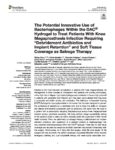The Potential Innovative Use of Bacteriophages Within the DAC ® Hydrogel to Treat Patients With Knee Megaprosthesis Infection Requiring « Debridement Antibiotics and Implant Retention » and Soft Tissue Coverage as Salvage Therapy
Infection is the most dramatic complication in patients with knee megaprosthesis. Its management is more complex in comparison with patients with primary arthroplasty, with a high risk of relapse. Lytic bacteriophages are considered to have a high potential in patients with prosthetic joint infection as it has been demonstrated that they have a synergistic anti-biofilm activity with antibiotics. The Defensive Antibacterial Coating (DAC®) hydrogel is a hydrogel available in the market that has been designed to prevent the adherence of bacteria on a prosthetic joint and to have the ability to transport and release anti-bacterial substances such as antibiotics. We report here the case of a patient with a catastrophic relapsing Staphylococcus aureus knee megaprosthesis infection without prosthesis loosening. We firstly perform phage susceptibility testing of the patient's strain to select an active cocktail, under the supervision of the French health authority. Then, we performed, as salvage therapy, a debridement and implant retention procedure with application of a selected cocktail of bacteriophages that was prepared extemporaneously within the DAC® hydrogel. A free flap for soft tissue coverage was required and empirical antibiotic treatment was started immediately after the surgery. Unfortunately, at 5 days after the surgery, while the local aspect of the surgical site was favorable, the patient developed myocardial infarction which required emergency stenting and dual antiplatelet therapy that were rapidly associated with bleeding at the surgical site, leading to a new prosthesis exposition. As a consequence, a transfemoral amputation was finally performed several months later. We also evaluated in vitro the impact of DAC® hydrogel on bacteriophage activity and showed that the selected phages were released very rapidly from the DAC® hydrogel, and then their titers were stable for at least 6 h. This case demonstrated the feasibility of the use of bacteriophages within a hydrogel to treat patients for knee megaprosthesis infection during a debridement procedure. The implementation requires identification of the pathogen before the debridement in order to perform phage susceptibility testing of the patient's strain and to identify a hospital pharmacist who will accept to do the preparation and to take the responsibility of the magistral preparation.



